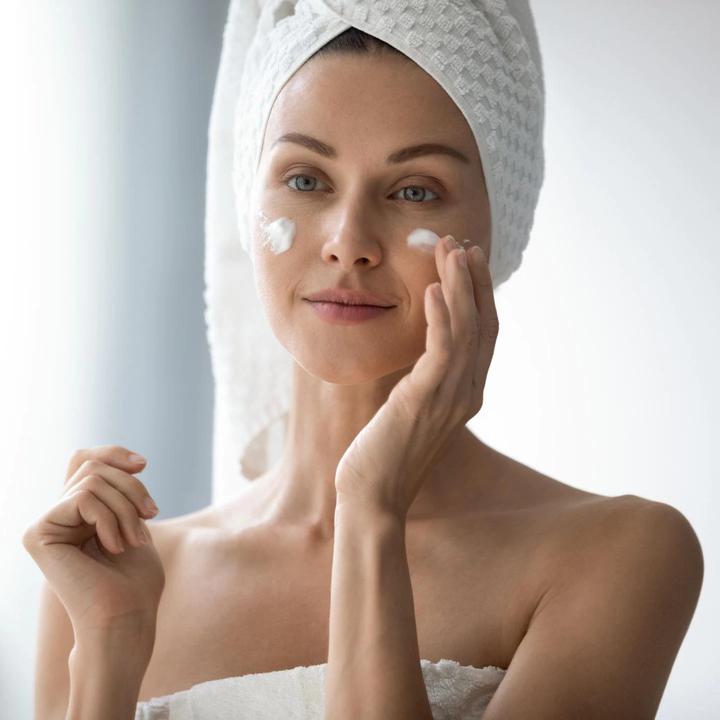
When we stand in front of the mirror in the morning and put on our make-up, we all probably think: That looks pretty good. As soon as we leave the house and look in the nearest pane of glass, we notice that it doesn't. Damn! Why is that? Because we didn't consider these eight things in the Foundation assignment. And hopefully that will change from now on!
1. You don't prep the skin
Applying foundation to bare skin isn't always a good idea. It is important that you ALWAYS use a skin care product underneath. It doesn't matter whether the make-up is moisturizing or skin-friendly - you can't do without it. The result will be blotchy and the product usually doesn't spread as well over the skin. However, the care should not be too greasy, otherwise the foundation slips back and forth on the skin. Many use a primer after the care. Can be done, does not have to be. However, if you want better hold, a glowing base, or refined pores, you can definitely use them.
2. You use the wrong tool
Do you always apply your foundation with your hands due to time constraints? Basically not bad at all. However, you should note that you cannot apply every product with the same tool. You should use different tools depending on whether you are working with a very light, liquid texture or with a highly opaque one. So that the result does not become blotchy, you should always apply foundations with a brush first. If that is too matt for you or the product "lies too much on the skin", you can rework with a beauty sponge. You can get even more coverage by applying some extra makeup with your hands.
3. You choose the wrong undertone
Have you ever wondered why you suddenly look like Miss Piggy or Bart Simpson himself after applying your make-up? With a foundation, it's not just how light or dark it is that counts, but also the right undertone. Because it's different for everyone. Generally there are yellow, pink, olive or neutral skin tones. If your makeup tone doesn't match the color of your skin, the result can look horrible very quickly. Finding the right undertone is often difficult, especially in drugstores, because of the limited selection - but it is definitely possible.
Be sure to test the foundation on your neck (and not your hands!) before you buy it and wait a few minutes. Many products oxidize and darken. Be sure to look at the color in daylight - this way you can see the undertone much better. You can get these foundations in more than ten different shades:
4. You don't know your skin type
If you have dry skin, you shouldn't necessarily wear a mattifying foundation. Unless you want your skin to feel like the Sahara at the end of the day. No thank you! For impure and oily skin, on the other hand, mattifying, rather opaque products are perfect, as they keep you matt for longer and also cover pimples and discolorations. Lighter formulas and foundations that promise glow are better choices for dry skin. But as always, exceptions prove the rule. That doesn't mean that people with dry skin can't wear high-coverage products. You know, every skin is different. Sometimes it is also a great alternative to mix two foundations together to achieve the perfect result. Try it!
5. You take too much product
A lot doesn't always help a lot - we're just saying Cake Face! When you put on make-up, it is better to use less product than too much. We often misjudge the amount and the result just looks pasted up. Not nice! Depending on what you apply the make-up with, you have to adjust the amount of product anyway. For example, a sponge absorbs more product than a brush. Only apply to the areas where you need more opacity and don't apply several layers across the board. Everyone sees that. This not only saves you the trouble in the morning, but also money because the foundation lasts longer.
6. You are following the wrong order
Cream products before powder products. If you've ever disregarded this rule, then you know what happens: you can kick your makeup in the bin. If you apply cream over powder, it often breaks down the powder textures and these wear away from the skin again. And you end up with a blotchy face and partially uncovered areas. That's exactly what we don't want. With a few exceptions - such as some cream highlighters - you should NEVER use the powder products first. So first apply foundation, concealer and co. - and only then can you continue with powder, blush and bronzer.
7. You put on makeup in the wrong light
Putting on makeup in front of the miniature bathroom mirror with no light is really not a good idea. Because as soon as you don't have good light, you can't really see colors or details when putting on make-up. This usually ends in makeup fringes or way too much color. If you don't have the opportunity to put on your make-up in daylight, just try a daylight lamp. There are now even mirrors that have integrated lights or real beauty lights, such as the "My Beauty Light". This works wonders and takes your makeup game to the next level. No lie!







